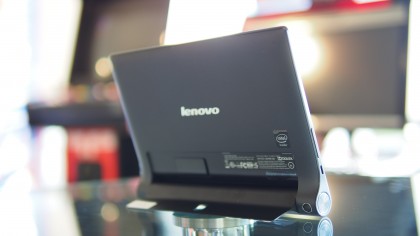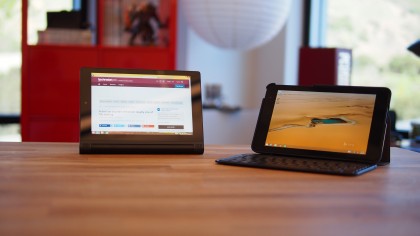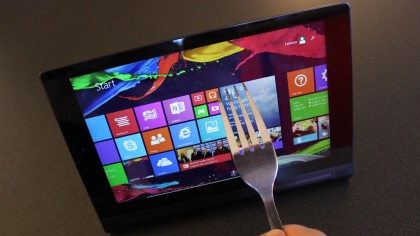Why you can trust TechRadar
Noticeably lacking on the Yoga Tablet 2 are ports. This means that tablet owners will likely need to use the Lenovo Tablet 2 primarily as a consumer tablet or rely on Bluetooth or Wi-Fi for expandability. Unless you're in the market for portability, business owners may want to shop for a larger tablet with full-sized USB ports.
That said, the issue of limited ports is fairly standard across a number of smaller slates, including those from Dell, Asus, and HP. Here's the Yoga Tablet 2 with AnyPen configuration sent to TechRadar for review:
Spec Sheet
- Processor: 1.33GHz Intel Atom Z3745 (quad-core, 2MB cache)
- Display: 8-inch Full HD (1,920 x 1,080) IPS
- Memory: 2GB
- GPU: Intel HD Graphics 5300
- Storage: 32GB (an additional 64GB via micro SD expansion)
- Camera: 1.6MP webcam; 8MP rear BSI camera
- Ports: micro USB, 3.5mm audio jack
- Weight: 0.94 pounds (0.43kg)
- Size: 8.27 x 5.87 x 0.28 inches (210 x 149 x 7 mm)
The micro USB port on the side is used to charge the tablet. If you need full USB functionality, you can pick up a micro USB on-the-go (USB OTG) adapter, which gives you access to a full-sized USB port. With an adapter, you can plug in a hard drive, keyboard, or flash drive.

Another feature that is missing is a video output port. The micro USB port on the Yoga Tablet 2 with Windows unfortunately does not support MHL capabilities, meaning you cannot get a dongle adapter and plug it into the HDMI port of an HDTV or monitor.
However, if you need to output your display to a larger screen, you can use wireless display (or WiDi) technology to mirror your screen. Likely Yoga Tablet 2 owners will live within the confines of their 8-inch panel.
The beauty and blemishes of an 8-inch screen
That's not necessarily a bad thing, as the 8-inch IPS display is beautiful, with wide viewing angles and a crisp 275 pixels-per-inch (ppi) resolution. The display looks fantastic indoors and under shade, but gets quickly washed out when under direct sunlight. If you're planning on using the Lenovo Tablet 2 as an e-reader on the beach, you may want to reconsider your option despite the excellent ergonomics and long battery life.
Unlike the Dell Venue 8 Pro, there isn't a custom keyboard accessory to transform the Yoga Tablet 2 8 Windows into a portable netbook. You can connect a full-sized Bluetooth keyboard and mouse, but the keyboard is almost twice as big as Lenovo's footprint for the tablet, negating the portability benefit.

Using Windows on an 8-inch screen feels cramped, and this is an endemic problem with running a desktop OS on a small display. Modern UI apps that are designed for touch work fine, with large buttons for finger use, but legacy programs for the classic desktop don't fare well. Navigating small text-based menus with fat fingers was problematic, unless you're poking at it with a pen via AnyPen technology.
AnyPen, but not with 'AnyApp'
This brings us to another quirk of the tablet: Lenovo's adoption of AnyPen. The technology makes stylus use convenient, as you can use almost any everyday object as a stylus. The problem is that choosing the wrong instrument could leave your screen with scratches over time.
Theoretically, you can use a knife, keys, a paper clip, scissors, or any metal object to draw with the tablet. However, if you use a knife and press too hard, you're not only making digital ink marks, but you can potentially leave analog etching on the glass screen. Similarly, choosing to write with a ballpoint pen can leave physical ink residue on the screen that's hard to wipe away.

Another issue is that some specialized inking apps, like Microsoft's popular OneNote, fail to recognize the metal object you're using as a stylus alternative. This means that you can use a paperclip to pan around or select menu items, but you can't write or draw.
I was successful in using the handwriting input panel, instead of the software keyboard, to input text that way. Though this seems slower than tapping on-screen keys, it could come in useful for inputting text in character-based languages.
On the Paint app, I didn't have any issues with sketching, but AnyPen lacked the pressure sensitivity that more advanced pens using N-Trig's or Wacom's technology offer. As such, AnyPen may not be suited as a stylus substitute for writing or drawing. You'll be fine if you're using your AnyPen stylus alternative to pan around the screen, select items, or do anything you traditionally would do with a mouse (or your fingers) for input.
The screen was too small for me to test palm rejection technology with AnyPen, but I can rest part of the side of my hand on the display while drawing on the screen with a ballpoint without issue.
Current page: Specifications, value and features
Prev Page Introduction and design Next Page Performance, benchmarks and software